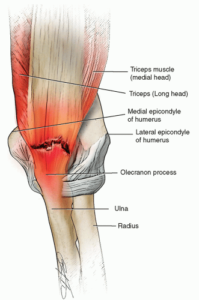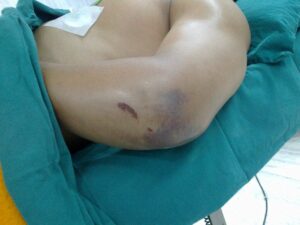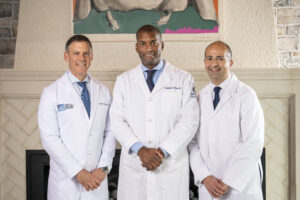Torn Triceps Tendon – A Rare But Serious Injury
Last Updated on October 21, 2023 by The SportsMD Editors
A torn tricpes tendon is a potentially career-threatening injury and torn tricep requires prompt surgical repair and significant rehabilitation to provide an athlete a viable chance at a return to play. Unfortunately, for Ray Lewis he is not alone, as triceps tendon injuries have had a serious impact on many athlete’s careers.
The torn tricep is the powerful muscle on the back of the upper arm that is responsible for straightening the elbow. It attaches to the shoulder blade on one end and to the elbow on the other. It is an important muscle in both everyday activities as well as in athletics.
What is a torn triceps tendon?
A torn triceps specifically refers to the tearing of the torn tricep tendon that attaches the powerful triceps muscle along the back of the arm to the tip of the elbow. Triceps ruptures commonly occur with falls onto an outstretched hand or during a block in football, when a sudden force causes the elbow to bend while the triceps muscle is simultaneously contracting and trying to straighten the elbow. The athlete’s body weight is resisted by the triceps contraction, however the force may be too much and the tendon ruptures.
Torn tricep symptoms
While a torn triceps tendon is relatively uncommon, they are devastating injuries for  athletes when they are missed and go untreated. For this reason, the doctor and athletic trainer must maintain a high index of suspicion. An injured athlete will describe a mechanism of injury where the elbow was forcibly bent while he or she was trying to extend it. There will be tenderness to the touch and swelling where the tendon attaches to the back of the elbow. There will also be weakness when the elbow is extended against resistance.
athletes when they are missed and go untreated. For this reason, the doctor and athletic trainer must maintain a high index of suspicion. An injured athlete will describe a mechanism of injury where the elbow was forcibly bent while he or she was trying to extend it. There will be tenderness to the touch and swelling where the tendon attaches to the back of the elbow. There will also be weakness when the elbow is extended against resistance.
An ultrasound or MRI can be very useful to confirm the diagnosis and specifically identify the location of the tear and degree of retraction of the tendon.
Torn Tricep Pictures

Treatment – How to fix a torn tricep muscle
Not all tricep tendon injuries are the same. A treatment plan should be tailored to each patient and it should depend on the characteristics of the tendon tear as well as the patient’s athletic level of sport, their goals and how high a level they want to perform.
Partial Tears:
May be treated without surgery and if there is not a significant loss of strength and flexibility. Nonsurgical treatment can be treated safely at home using the P.R.I.C.E. principle. The acronym stands for:
- Protection
- Rest
- Ice
- Compression
- Elevation
The principles of P.R.I.C.E. should be used for the first 48 – 72 hours immediately after the injury. The goal during this time frame is to control the amount of swelling to the injured area, prevent further injury, and reduce pain. Following these principles can effectively reduce the amount of swelling in an injured area thereby reducing the amount of time required for rehabilitation.
You may also use temporary splinting or bracing to help protect the injured tricep and arm. It’s recommended to see a physical therapist who can help your recovery and provide the necessary stretching and strength exercises to help you properly recover.
For competitive athletes or highly active individuals such as weight lifters, partial tears may also require surgery if conservative measures fail.
Torn Tricep Surgery:
Complete ruptures of the triceps tendon typically require surgery in athletes who wish to return to play at the prior level of competition. An incision is necessary on the back of the elbow to reattach the tendon directly to bone. The surgery repair involves placing stitches in the tendon and anchoring them to the tip of the elbow either with suture anchors or through tunnels drilled in the bone. As with most tendon repairs, the surgeon then has to get the tendon to heal in that position. If this injury is missed or neglected, the athlete will have significant weakness with elbow extension and may not be able to maintain a block in football or rugby, lift weights, or perform push-ups.
Torn Tricep Surgery Recovery Time
After surgery healing requires immobilization of the arm and a splint or brace is used for about two to three weeks. The tendon will need to heal in the repaired position and exercises are started slowly to regain elbow motion. About four to six weeks after surgery, active motion exercises will be performed. It’s important that you use a physical therapist to aid you in your recovery and exercises. Doing too much, too fast, increases the risk of injury. Once you have full range of elbow motion, strengthening exercises can start and this usually starts at four to six months after surgery. Most patients can expect to have a full range of motion and recovery from a torn tricep in about one year after surgical repair.
When to See a Sports Medicine Doctor
Hundreds of athletes sustain acute injuries every day, which can be treated safely at home using the P.R.I.C.E. principle. But if there are signs or symptoms of a serious injury, emergency first aid should be provided while keeping the athlete calm and still until emergency service personnel arrive. Signs of an emergency situation when you should seek care and doctor treatment can include:
- Bone or joint that is clearly deformed or broken
- Severe swelling and/or pain,
- Unsteady breathing or pulse
- Disorientation or confusion
- Paralysis, tingling, or numbness
In addition, an athlete should seek medical care if acute symptoms do not go away after rest and home treatment using the P.R.I.C.E principle.
Get a Telehealth Appointment or Second Opinion With a World-Renowned Orthopedic Doctor
 Telehealth appointments or Second Opinions with a top orthopedic doctor is a way to learn about what’s causing your pain and getting a treatment plan. SportsMD’s Telehealth and Second Opinion Service gives you the same level of orthopedic care provided to top professional athletes! All from the comfort of your home.. Learn more via SportsMD’s Telemedicine and Second Opinion Service.
Telehealth appointments or Second Opinions with a top orthopedic doctor is a way to learn about what’s causing your pain and getting a treatment plan. SportsMD’s Telehealth and Second Opinion Service gives you the same level of orthopedic care provided to top professional athletes! All from the comfort of your home.. Learn more via SportsMD’s Telemedicine and Second Opinion Service.

